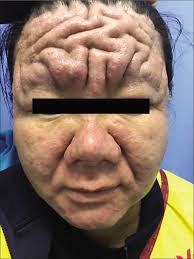 Cutis verticis gyrata is a medical condition usually associated with thickening of the scalp.
Cutis verticis gyrata is a medical condition usually associated with thickening of the scalp.
There is excessive thickening of the soft tissues of the scalp and characterized by ridges and furrows.
CVG gives the scalp a cerebriform appearance.
The ridges are hard and cannot be flattened out, with visible folds, ridges or creases on the surface of the top of the scalp.
The number of folds can vary from two to roughly ten and are typically soft and spongy.
It typically affects the central and rear regions of the scalp.
Rarely, it can involve the entire scalp.
Hair loss can occur over time where the scalp thickens.
Hair within furrows remains normal.
Its cause(s) are as yet undetermined.
It is not congenital.
There is no clinical diagnosis for CVG as cases are rarely seen and are often comorbid with other conditions.[citation needed]
Some studies suggest that CVG occurs in individuals in a secondary form to other ailments, but the condition can also be present on its own.
There two forms of GVC : primary’ (essential and non-essential) and ‘secondary’.
Primary essential CVG is where the cause of the condition in unknown, and has no other associated abnormalities.
This occurs mainly in men, with a male:female ratio of 5:1 or 6:1, and develops during or soon after puberty.
Primary non-essential CVG can be associated with neuropsychiatric disorders including cerebral palsy, epilepsy, seizures, and ophthalmologic abnormalities, most commonly cataracts.
Secondary CVG occurs as a consequence of a number of diseases or drugs that produce changes in scalp structure: acromegaly due to pituitary gland tumors, and theoretically, the use of growth hormone itself.
CGV may also arise in association with melanocytic nevi, birthmarks, fibromas and inflammatory processes of eczema, psoriasis, Darier disease, folliculitis, impetigo, atopic dermatitis, and acne.
Treatment for this condition have been limited to plastic surgery with excision of the folds by means of scalp reduction.
Scalp subcision, injections of a dermal filler, and hyaluronidase injections are possible treatments.
